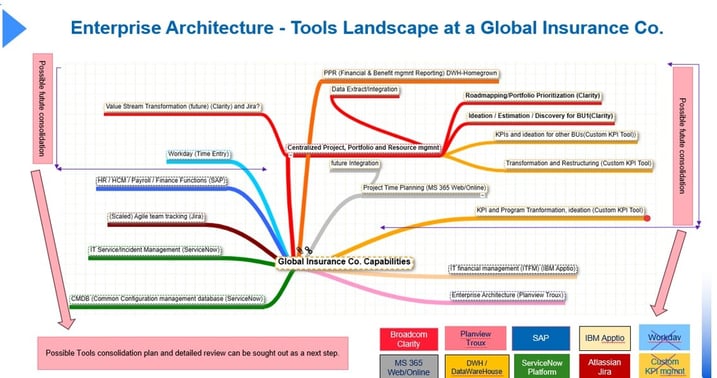March 6, 2025

Reducing Tools TCO Through an Architecture Review
A Broadcom Knight provides a real-world case study about how he has modeled and proposed to achieve 20% to 30% reduction in IT costs for a global enterprise customer
4 min read

Written by: Nilashis Chatterjee
|
Key Takeaways
|
|
 In my previous Broadcom Knights’ blog articles, I shared the many business drivers and best practices using the Clarity modern UX. As a Solution Architect and Broadcom Knight, my role sometimes goes beyond just helping customers with product adoption to looking at their enterprise landscape to help them identify and track TCO (total cost of ownership) reduction throughout their Broadcom solution journey.
In my previous Broadcom Knights’ blog articles, I shared the many business drivers and best practices using the Clarity modern UX. As a Solution Architect and Broadcom Knight, my role sometimes goes beyond just helping customers with product adoption to looking at their enterprise landscape to help them identify and track TCO (total cost of ownership) reduction throughout their Broadcom solution journey.
Tracking TCO reduction: How does it work?
At HCLTech, our TCO reduction model is based on the TOGAF® Standard, a standard of the The Open Group that is a proven Enterprise Architecture methodology and framework and backed by the Architecture Development Method. Our focus is to help customers identify and track TCO reduction throughout the Broadcom solution journey starting from inception until at least the Technology Architecture phase below. If they select Broadcom solutions such as Clarity, Rally, ConnectALL, and ValueOps Insights, we help them through change management of the entire architecture migration.
Starting point of our analysis |
Endpoint of our analysis |

|

|
Reducing complexity, reducing TCO: A case study
Many enterprises find themselves drowning in overlapping tools, redundant costs, and inefficient systems. One global organization faced this exact challenge—multiple departments, each using their own software, leading to rising costs and inconsistent ways of working. I was asked to help, not by forcing a drastic overhaul, but by designing a structured, phased approach to consolidation in multiple steps, working alongside the enterprise architects. This effort was NOT to replace the existing architects within the customer organization; instead, it was to collaborate with them to plan and showcase the business value and cost reduction models. The goal? Reduce costs over time while ensuring teams still have the functionality needed, in a gradual transition.
The Challenge: too many planning and management tools, too much complexity with limited visibility

Over time, the company’s IT ecosystem had become a maze of disconnected planning systems with overlapping functionalities. Workday handled time entry; SAP covered HR, payroll, and finance; Jira tracked agile teams; and Microsoft 365 managed project time planning, while a KPI tool and Clarity overlapped on KPIs, transformation, and portfolio planning. Each tool had a purpose but, together, they created unnecessary complexity and cost.
Departments were attached to their systems. They had specific needs and valid concerns about change. The challenge wasn’t just technical; it was about aligning people, processes, business goals and for most enterprises, a cultural mindset change. Instead of forcing an abrupt overhaul, we worked closely with business units to analyze usage patterns, integration challenges, and team dependencies. Throughout this collaborative process, we built a phased consolidation plan, centralizing project, portfolio, and resource management within Clarity, while preserving essential functions from other tools thru REST API based integrations, directly connecting them in real-time.
Rather than pushing a one-size-fits-all solution, we built a strategy that made sense for the business by taking the following steps:
- Identified redundancies: Mapped tool usage to pinpoint overlapping features and underused systems, mapping their business capabilities in a gap analysis model to identify redundancies/improvement opportunities. Our model is not just based on direct costs (licenses, support fees) but also hidden costs with assumptions such as training, administration, and the productivity loss due to fragmented systems.
- Engaged stakeholders: Worked closely with teams to understand critical needs and address concerns early.
- Planned a phased transition: Designed a step-by-step approach to minimize disruption, finding champions within the organization to adopt them early when possible.
- Standardized on Clarity: Used Broadcom Clarity as the central hub for portfolio and resource management, while integrating essential functions from other tools. Use the roadmap capabilities to showcase the entire transitional phases and milestones, capturing TCO reduction over time directly into the tool for complete transparency.
The results: Cost savings and simplicity
By focusing on practical changes instead of forcing immediate overhauls, we delivered real value:
- Modeled between 25-30% reduction in IT costs from reduced license, OpEx and service fees.
- A simpler, more efficient toolset that improved standardization.
- Stronger collaboration with teams working from a unified system.
- Better return on existing investment and more importantly, reduced risk for future investment, which is often overlooked.
- Buying decisions are simpler, because the information governing procurement is readily available in a coherent plan.
This wasn’t just about saving money—it was about creating an IT environment that worked better, scaled easily, and supported long-term business goals. It also improved visibility in all levels while reducing duplication of efforts/redundancy/technical debt over the years.
Why this approach to TCO works
Most companies avoid tool consolidation because of the risks—losing key functionality, disrupting operations, or facing internal pushback. But by taking a business-first approach, we ensure:
- Data-driven architecture-decisions, not assumptions
- Minimal operational disruption
- Alignment with business and IT strategy
- A clear, stepwise roadmap
Tool consolidation isn’t just about cutting costs—it’s about making IT investments work smarter.
Want to streamline your IT landscape and cut unnecessary costs while looking at Broadcom Products you might already have or looking to invest in? Let’s talk about how a tailored enterprise architecture review can help for your specific situation.
- Learn more about Clarity by Broadcom
- Learn more about HCLTech Consulting Services

Nilashis Chatterjee
Nilashis has spent over 18 years harnessing an innovative industry presence to drive brand awareness and leading geographically/culturally diverse teams around the world. He specializes in the Digital Transformation and Advisory Consulting area in Service Management, Project, Program, Product, Portfolio Service...
Other resources you might be interested in
Why 2025 Shattered the Old Rules of Network Management
This post reveals the five key lessons network operations leaders learned in 2025—and how they need to respond to be successful in 2026.
The 2026 VMUG Report: Why Network Observability is the Heart of the New VCF Era
Get the top takeaways from the VMUG Cloud Operations and VCF User Experience Report 2026. See why network observability is key to successful VCF 9 migrations.
Automic Automation Cloud Integration: SAP S/4 HANA Application Jobs Integration
Simplify your SAP S/4HANA job management. Integrate with Automic Automation for central configuration, monitoring, and orchestration of all your enterprise jobs.
Automic Automation Cloud Integration: OpenSSH Integration
Master Open SSH automation. Use Automic Automation for centralized control, secure file transfer, command execution, and full job monitoring.
3 Questions I Expect You to Ask Me
Ask these questions to gain a deeper understanding of a vendor. Find a partner who can solve today’s challenges and prepare you for what’s next.
Carrier-Grade Network Observability: A Technology Brief for Telco Network Operations
Network Observability by Broadcom unifies data to provide contextual, AI-enabled insights for superior service availability, accelerated MTTR and improved MTTI, reduced operational costs, and the...
Rally Office Hours: December 4, 2025
Get the latest Rally updates, including a new Release Tracking page, and hear Q&A on revision history reporting, custom boards, and capacity planning.
You've Found the Waste In Your Network Operations. Now What?
Leverage the Six Sigma framework to gain a roadmap for converting network data into permanent optimizations. Start systematically eliminating network issues.
AAI Integrations: Control-M
This course explains how to install, configure, and secure the integration between Automation Analytics & Intelligence (AAI) and Control-M.